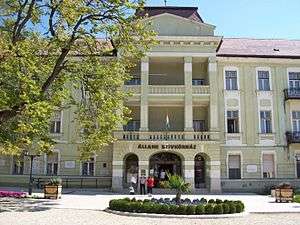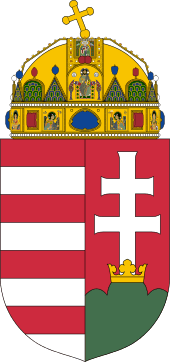Healthcare in Hungary

Hungary has a tax-funded universal healthcare system, organized by the state-owned National Health Insurance Fund (Hungarian: Országos Egészségbiztosítási Pénztár (OEP)). According to the OECD 100% of the total population is covered by universal health insurance,[1] which is absolutely free for children (all people under 16), mothers or fathers with baby, students, pensioners (everyone over 62), people with low income, handicapped people (including physical and mental disorders),[2] priests and other church employees.[3] Health in Hungary can be described with a rapidly increasing life expectancy (7.48 years for men and 4.92 years for women between 1993 and 2013)[4] and a very low infant mortality rate (4.6 per 1,000 live births in 2014).[4] According to the OECD Hungary spent 7.8% of its GDP on health care in 2012. Total health expenditure was 1,688.7 US$ per capita in 2011, 1,098.3 US$ governmental-fund (65%) and 590.4 US$ private-fund (35%).[5]
History
.jpg)


The first hospitals go back to the 13th-century mining towns of Hungary. The first mining health insurance was founded by János Thurzó in 1496. The first modern insurer was established in 1907, named Országos Munkásbetegsegélyező és Balesetbiztosító Pénztár ("National Workers' Sick-benefit and Accident Fund").
The first steps to overall health insurance took place in the Horthy era with the creation of Országos Társadalombiztosítási Intézet (lit. "National Social Insurance Institution") in 1928 (This is the predecessor of present-day Országos Egészségbiztosítási Pénztár.). Social services were complete to 1938, at that time the Hungarian social health insurance system was the most progressive and charitable in East-Central Europe.
After the World War II the Communist government fully nationalized social insurance. Since then the Hungarian healthcare system has been state-owned, overall and available for all of the people.[6]
The free-market shift initiated after the end of communist rule 27 years ago put a strain on the largely centralised, wholly tax-funded public health system, which required far-reaching reforms.[7] These resulted in the creation of the National Healthcare Fund (Hungarian: Országos Egészségbiztosítási Pénztár), in 1993.[8] The OEP, predominantly based on a social insurance system,[7] is the public organization currently controlling the management of health care in Hungary.[8] 83% of the financing for health care comes from taxes and other public revenues.[9]
Participation in the insurance scheme is mandatory for everyone in the workforce, including the self-employed.[10] Most private hospitals also operate under the OEP framework.[8] Because of past hiring policies, Hungarian hospitals often have redundancies of doctors, and a lack of nurses, resulting in an unproductive misuse of human resources.[7]
So-called "gratitude payments", another communist legacy, require in practice a cash payment to have access to better treatments.[7] According to the survey conducted by the Euro health consumer index in 2015 Hungary was among the European countries in which unofficial payments to doctors were reported most commonly.[11]
Medical treatment deemed "medically necessary" is provided free of charge for European citizens in the country.[12]
Infrastructure
As a high-income nation, Hungary has a relatively developed health infrastructure. Ambulances of the Országos Mentőszolgálat (OMSZ, "National Ambulance Service") reach all over the country at the very latest 15 minutes. In 2013 OMSZ built 20 new ambulance stations and renewed 60 others with the purchase of 200 new ambulances.[13]
Air ambulance service was completed in 2009 with the grand opening of Szentes air ambulance station. Air ambulance bases (in Budaörs, Balatonfüred, Sármellék, Pécs, Szentes, Debrecen, Miskolc) cover the whole country. Helicopters can reach 85% of the country's territory at the very latest 15 minutes. All national and county hospitals have heliports, including the specialized and most professional university clinics and emergency centres in Budapest, Pécs, Szeged and Debrecen.[14][15]
Medical tourism

Hungary is one of the main destinations of medical tourism in Europe. The country leads in dental tourism,[16][17] its share is 42% in Europe and 21% worldwide.[17][18] The first medical tourists were Germans and Austrians in the 1980s, looking for cheap and top-quality dentistry services.[19] Since the fall of Communism medical tourism is an emerging business,[18] 60,000-70,000 people visit Hungary for dental treatments every year, making 65–70 billion HUF (~325–350 million $) revenue only in the dental sector.[17] The cost of medical treatments is between 40% and 70% of the cost in the United Kingdom, United States and Scandinavian countries.[19] The most popular medical treatments are dentistry, cosmetic surgery, orthopaedic surgery, cardiac rehabilitation, fertility treatment, dermatology, anti-aging treatment, obesity treatment, addiction programmes and eye surgery.[19] Plastic surgery is also a key sector. 30% of the clients come from abroad. They can save 40-80% on medical expenses.[20] Hungary is home to several medicinal spas[19] (Lake Hévíz, Széchenyi Medicinal Bath etc.), spa tourism sometimes combined with other treatments.[20]
See also
- Health in Hungary
- Hungarian Food Safety Office
- Hungarian fees abolishment referendum, 2008
- List of hospitals in Hungary
References
- ↑ OECD (June 27, 2013). "OECD Health Data: Social protection". OECD Health Statistics (database). Paris: OECD. doi:10.1787/data-00544-en. Retrieved 2013-07-14.
- ↑ List of the entitled people for free insurance, National Healthcare Fund, 2013
- ↑ Dőzsölők és szűkölködők - Miből gazdálkodnak az egyházak?, Figyelő (financial status of the churches in Hungary, Hungarian)
- 1 2 Vital statistics, Hungarian Central Statistical Office (KSH)
- ↑ Health: Key Tables from OECD, OECDiLibrary
- ↑ History of social insurance in Hungary, National Healthcare Fund
- 1 2 3 4 Hungary’s Healthcare System
- 1 2 3 OEP - Főigazgatói köszöntő
- ↑ Egészségügyi Minisztérium - The organisation and functioning of health insurance in hungary
- ↑ World Health Organization - Hungary
- ↑ "Outcomes in EHCI 2015" (PDF). Health Consumer Powerhouse. 26 January 2016. Retrieved 27 January 2016.
- ↑ Health Care Services Available During Temporary Stay in Hungary
- ↑ Tényleg kiérnek a mentők 15 perc alatt ("Ambulances get to under 15 minutes"), Népszava (Hungarian)
- ↑ Átadták a légimentő bázist - a legmodenebb az országban ("Air ambulance base has opened - the most modern in the country"), Városi Visszhang (Hungarian)
- ↑ Air ambulance bases in Hungary, Hungarian Air Ambulance Plc. (English)
- ↑ Hungary leading in Dental Tourism in Europe, Budapest Agent (English)
- 1 2 3 Hungary aims at bigger bite of dental tourism, Budapest Business Journal (English)
- 1 2 Dental Tourism Development clinics turnover up 19%, Budapest Business Journal (English)
- 1 2 3 4 Hungarian Tourism promotes medical tourism, International Medical Travel Journal (English)
- 1 2 Medical tourism in good health, Budapest Business Journal (English)
